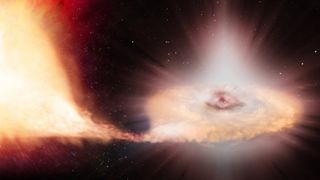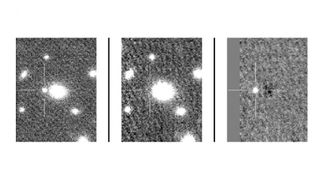Citizen Scientists Identify Prehistoric Supernova
More than 700 volunteer citizen scientists have helped identify more than 30,000 celestial objects, including a star explosion that occurred 970 million years ago, hundreds of millions of years before dinosaurs emerged on Earth.
When a massive star reaches the end of its life, it creates a bright stellar explosion, also known as a supernova. The Australian National University (ANU) has invitied citizen scientists to join the hunt for supernovas.
Using images taken by the SkyMapper telescope at the ANU Siding Spring Observatory, volunteer supernova hunters helped discover a star's dying burst located roughly 970 million light-years from Earth, according to a statement from ANU. That means the star exploded millions of years before dinosaurs roamed the planet. [Supernova Photos: Great Images of Star Explosions]

"This is the exact type of supernova we're looking for — Type Ia supernova — to measure properties of and distances across the universe," Brad Tucker, co-lead researcher from the ANU Research School of Astronomy and Astrophysics, said in the statement.
The exploding star, called SN2017dxh, is one of seven potential new supernovas reported to the Transient Name Server; the team is tracking another 18 potential supernovas as well, according to the statement.
Supernovas, "which are explosions as bright as 100 million billion billion billion lightning bolts," researchers said in the statement, can be used to track how the universe is growing and to better understand mysterious dark energy. Based on the brightness and fading of light emitted by a supernova, astronomers can measure how far away a supernova is from Earth, the researchers said.

The ANU project was set up on the Zooniverse platform and allows volunteers to look through images taken by the SkyMapper telescope for differences that may hint at the presence of a supernova. The volunteers note the differences they observe so that the researchers can follow up on them and determine what they mean.
Get the Space.com Newsletter
Breaking space news, the latest updates on rocket launches, skywatching events and more!
"In the first 24 hours, we had over 30,000 classifications" of new celestial objects, Anais Möller, another co-lead researcher from ANU, said in the statement. "We've almost reached 40,000 classifications, with more than 1,300 images classified, since the launch of our project."
When the discovery is reported to the International Astronomical Union, the first three people to find a previously unknown supernova will be mentioned. You can participate in the ANU citizen science project online.
Follow Samantha Mathewson @Sam_Ashley13. Follow us @Spacedotcom, Facebook and Google+. Original article on Space.com.
Join our Space Forums to keep talking space on the latest missions, night sky and more! And if you have a news tip, correction or comment, let us know at: community@space.com.

Samantha Mathewson joined Space.com as an intern in the summer of 2016. She received a B.A. in Journalism and Environmental Science at the University of New Haven, in Connecticut. Previously, her work has been published in Nature World News. When not writing or reading about science, Samantha enjoys traveling to new places and taking photos! You can follow her on Twitter @Sam_Ashley13.











